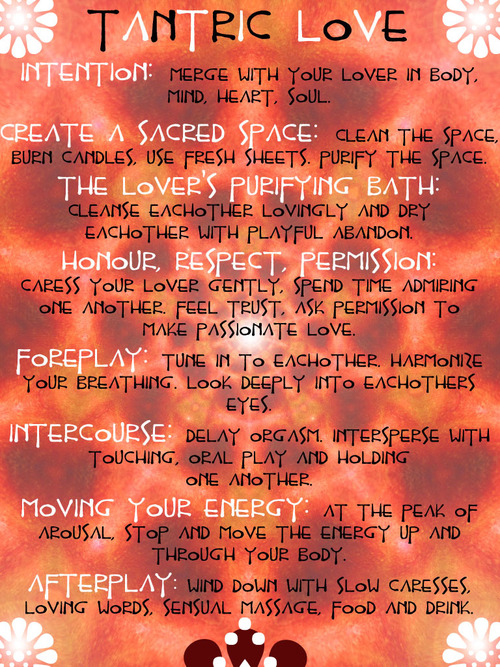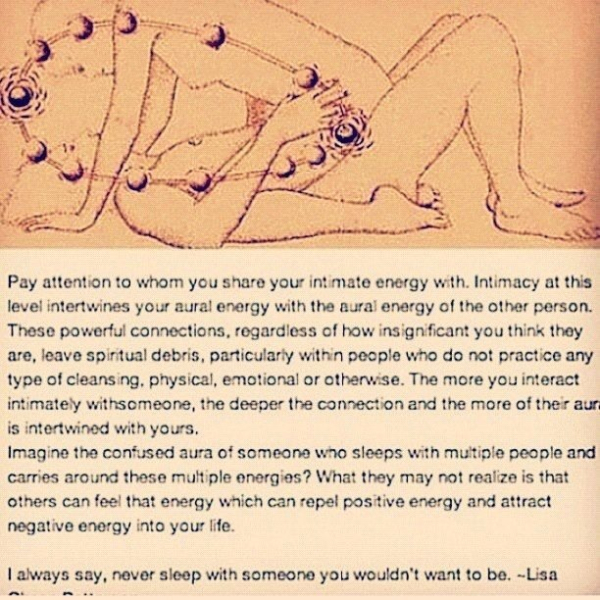P Diddy shined a spotlight on tantric sex with just one tweet:
Having tantric sex!!!! I feel so much better.!!! Thank you
— Diddy (@iamdiddy) February 27, 2009
However, sexual Tantra has been around “since early Hindu Tantra as a means of catalyzing biochemical transformations in the body to facilitate heightened states of awareness.”
“Tantric texts specify that sex has three distinct purposes: procreation, pleasure and liberation. Those seeking liberation eschew orgasm in favor of a higher form of ecstasy. Several sexual rituals are recommended and practiced, involving elaborate preparatory and purification rites.”
Here is a short definition:
There are some basic ideas that are common in practicing tantric love:
It is important to learn about meditation so that one can establish a daily personal meditation practice which will greatly help when practicing tantric sex:
There are many websites like this one that can give step by step tips to practicing tantric sex:
1. Try the heart breath to tune into each other. Stand opposite one another and look into each other’s eyes placing your left hand on your partner’s heart. He should then place his hand over your left one and you should try to match each other’s breathing for at least two minutes.
2. Sit face-to-face (this works better if you sit in his lap). Wrap your arms as tightly around one another and press your body against each other. This kind of skin contact promotes greater feelings of intimacy.
3. Ensure you move and breathe slowly during sex (it can help to avoid any position that you know makes you orgasm easily) and work towards a gradual build-up of pleasure. The more slowly you can allow your feelings and sensations to build up, the more intense your eventual orgasm will be
Tantric sex exercises
As Tantric sex is all about intimacy between two partners, the following exercises can help you get a hang of Tantra:
1. Try the heart breath to tune into each other. Stand opposite one another and look into each other’s eyes placing your left hand on your partner’s heart. He should then place his hand over your left one and you should try to match each other’s breathing for at least two minutes.
2. Sit face-to-face (this works better if you sit in his lap). Wrap your arms as tightly around one another and press your body against each other. This kind of skin contact promotes greater feelings of intimacy.
3. Ensure you move and breathe slowly during sex (it can help to avoid any position that you know makes you orgasm easily) and work towards a gradual build-up of pleasure. The more slowly you can allow your feelings and sensations to build up, the more intense your eventual orgasm will be.
Read more at http://www.goodtoknow.co.uk/relationships/273020/tantric-sex#LyECLxiqEwCbXs8A.99
Tantric sex exercises
As Tantric sex is all about intimacy between two partners, the following exercises can help you get a hang of Tantra:
1. Try the heart breath to tune into each other. Stand opposite one another and look into each other’s eyes placing your left hand on your partner’s heart. He should then place his hand over your left one and you should try to match each other’s breathing for at least two minutes.
2. Sit face-to-face (this works better if you sit in his lap). Wrap your arms as tightly around one another and press your body against each other. This kind of skin contact promotes greater feelings of intimacy.
3. Ensure you move and breathe slowly during sex (it can help to avoid any position that you know makes you orgasm easily) and work towards a gradual build-up of pleasure. The more slowly you can allow your feelings and sensations to build up, the more intense your eventual orgasm will be.
Read more at http://www.goodtoknow.co.uk/relationships/273020/tantric-sex#LyECLxiqEwCbXs8A.99
Tantric sex exercises
As Tantric sex is all about intimacy between two partners, the following exercises can help you get a hang of Tantra:
1. Try the heart breath to tune into each other. Stand opposite one another and look into each other’s eyes placing your left hand on your partner’s heart. He should then place his hand over your left one and you should try to match each other’s breathing for at least two minutes.
2. Sit face-to-face (this works better if you sit in his lap). Wrap your arms as tightly around one another and press your body against each other. This kind of skin contact promotes greater feelings of intimacy.
3. Ensure you move and breathe slowly during sex (it can help to avoid any position that you know makes you orgasm easily) and work towards a gradual build-up of pleasure. The more slowly you can allow your feelings and sensations to build up, the more intense your eventual orgasm will be.
Read more at http://www.goodtoknow.co.uk/relationships/273020/tantric-sex#LyECLxiqEwCbXs8A.99










